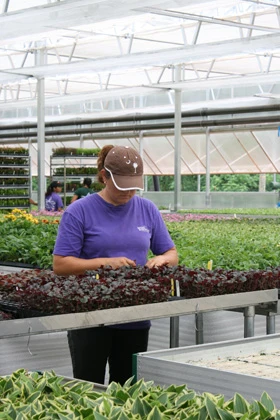
Soils and potting media provide plants and other organisms with nutrients and habitats. Because bacterial and fungal microorganisms (a.k.a. microbes) in soils and potting media are constantly vying for food, water and space, soils are regarded as dynamic living environments. Microbes in these substrates obtain nutrients by competing with each other for dead organic matter, feeding on other living organisms (including each other), and/or interacting cooperatively with other organisms.
How soil microorganisms directly or indirectly affect plant growth and health determines if they are considered beneficial, harmful or insignificant to plants. Microbes that harm plants are plant pathogens since the harm that they cause is considered disease. On the other hand, beneficial microorganisms can either enhance plant growth, suppress plant diseases or both.
Plant disease suppression
Beneficial microbes help to control plant diseases by the following mechanisms:
Predation and hyperparasitism = feeding on pathogens;
Antagonism, competitive exclusion and microbiostasis = competing for nutrients or space by producing metabolites that kill pathogens or inhibit their growth and movement;
Rhizosphere competency = blocking pathogen access to plant roots;
Induced systemic resistance and systemic acquired resistance = stimulating or priming the plant’s own natural defense system.
As a general rule, disease-suppressive microorganisms work best at preventing rather than curing diseases. Examples of commercially available beneficial microbes include bacterial strains belonging to the genera Bacillus, Streptomyces, and Pseudomonas, and fungal isolates belonging to the genera Trichoderma and Glomus. The list of commercially available beneficial microbes is dwarfed in comparison to the wide variety of native beneficial soil microbes found in healthy soils.
Commercially available beneficial bacterial strains of Bacillus and Streptomyces grow near the roots, releasing secondary metabolites that inhibit pathogen growth by causing cell membranes to become “leaky.” Some of these commercial microbes and certain native bacterial strains also act as plant-growth promoting rhizobacteria or PGPRs by improving nutrient availability to the plant and through their interactions with host plants. Many PGPR strains of the bacteria described above have also been shown to induce systemic resistance in some plant species.
Certain beneficial fungi grow near, on and inside root tissue. The mycoparasite, Trichoderma harzianum isolate T-22 provides several beneficial effects. It preventively controls diseases through rhizosphere competence, hyperparasitism, and competitive inhibition and antagonism. T-22 also promotes plant growth as do other Trichoderma isolates. Mycorrhizal fungi from the genus Glomus grow in and around roots of many mycorrhizal plant species to help supply host plants with insoluble phosphorus, especially in highly mineralized soils and container media. Several different mycorrhizal products are commercially available either as mycorrhizal spore preparations or formulated with fertilizers.
Keys to effective use
Understanding the strengths, requirements, limitations and general biology of a beneficial microorganism is crucial for obtaining the greatest benefits. Commercial microbes are added in large numbers to the soil by mixing in granules or by drenching before pathogen pressure is high. Knowing the environmental conditions under which the beneficial microbe performs best will help ensure the health and protection of the plant. Additionally, compatibility with the crop production system and grower inputs should be considered for the proper use of beneficial microorganisms. Soil pH, temperature, humidity, soil or container medium composition, and target plant tissue (root, tuber, etc.) all affect the establishment of beneficial microbes in the soil. Also important are how pesticide inputs, nutrient inputs, irrigation method and frequency, plant growth regulators, etc., affect beneficial microbe performance or longevity.
Longevity of a beneficial microbe or microbes in the soil or potting mix environment is a benefit for long-term crops. Bacteria tend to release their protective secondary metabolites for up to four weeks after application, even though they may persist in the soil environment longer. Fungi tend to survive longer with protection documented for up to 12 weeks. Ultimately all introduced beneficial microbes must be re-introduced to maintain protective levels in soils and potting media.
Chris Hayes is the BioWorks Southeast Technical Sales Manager and Matthew Krause is the Product Development Manager, Plant Disease Management for BioWorks.
Latest from Greenhouse Management
- Anthura acquires Bromelia assets from Corn. Bak in Netherlands
- Top 10 stories for National Poinsettia Day
- Langendoen Mechanical hosts open house to showcase new greenhouse build
- Conor Foy joins EHR's national sales team
- Pantone announces its 2026 Color of the Year
- Syngenta granted federal registration for Trefinti nematicide/fungicide in ornamental market
- A legacy of influence
- HILA 2025 video highlights: John Gaydos of Proven Winners





